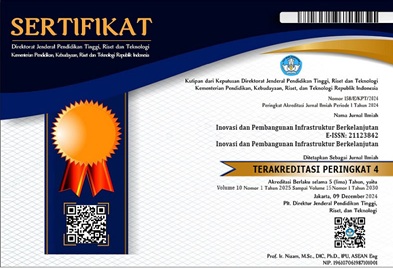ANALISA PRODUKTIVITAS TENAGA KERJA PADA PEKERJAAN PEMBESIAN DAN BEKISTING PADA PROYEK PEMBANGUNAN TPT DI DESA SIMODIKARAN
Kata Kunci:
produktivitas, productivity rating, bekestingAbstrak
Pada proyek pembangunan TPT di Ds. Simodikaran ini mengambil penelitian tentang pembesian dan bekesting pada kolom dan plat lantai, pekerjaan pembesian kolom dan plat lantai merupakan salah satu pekerjaan konstruksi yang sangat penting. Kolom berfungsi agar bangunan tidak mudah roboh dan plat lantai berfungsi sebagai tempat berpijak. Salah satu hal yang menjadi faktor menunjang keberhasilan proyek adalah tersedianya berbagai sumber daya manusia yang memadai dan expert dibidangnya. Produktivitas tenaga kerja sangat dibutuhkan dan harus dimaksimalkan untuk mendapatkan hasil yang baik pada proyek konstruksi. Metode yang digunakan adalah kuantitatif dan qualitative yaitu menganalisa faktor – faktor yang mempengaruhi produktivitas tenaga kerja dengan menggunakan metode productivity rating. Besar nilai produktivitas tenaga kerja pada proyek pembangunan Tembok Penahan Tanah (TPT) di Desa Simodikaran ini, pada pekerjaan pembesian memiliki rata-rata produktivitas LUR sebesar 66,98% serta pada pekerjaan bekisting memiliki rata-rata produktivitas LUR sebesar 67,42%. Sehingga dari hasil analisis nilai LUR pada setiap tenaga kerja tersebut cukup memuaskan karena untuk nilai faktor utilitas pekerja lebih dari 50%. Faktor yang mempengaruhi produktivitas tenaga kerja ialah banyaknya pengalaman tenaga kerja dengan koefisien sebesar 0,878, hal tersebut menjadikan tenaga kerja tersebut lebih cekatan dalam melaksanakan pekerjaan. Sedangkan koefisien faktor penyebab produktivitas tenaga kerja yang terendah ialah upah yang kecil tidak mempengaruhi produktivitas tenaga kerja dengan koefisien sebesar 0,289.
In the TPT construction project in Simodikaran Village, this research focuses on reinforcement and formwork for columns and floor slabs. The reinforcement work for columns and floor slabs is one of the most important tasks in construction. Columns serve to prevent buildings from easily collapsing, while floor slabs function as a place to stand. One of the factors that supports the success of a project is the availability of adequate human resources who are experts in their fields. Labor productivity is essential and must be maximized to achieve good results in construction projects. The method used is both quantitative and qualitative, which involves analyzing the factors that influence labor productivity by using the productivity rating method. The productivity value of labor on the construction project of the Soil Retaining Wall (TPT) in Simodikaran Village shows that in the rebar work, the average labor productivity value (LUR) is 66.98%, while in the formwork work, the average LUR is 67.42%. Therefore, the analysis results of the LUR values for each laborer are quite satisfactory, as the utility factor value for workers is above 50%. The factor influencing labor productivity is the amount of experience of the workers, with a coefficient of 0.878, which makes the workers more adept at carrying out their tasks. Meanwhile, the factor with the lowest coefficient affecting labor productivity is low wages, which does not significantly impact productivity, with a coefficient of 0.289.





